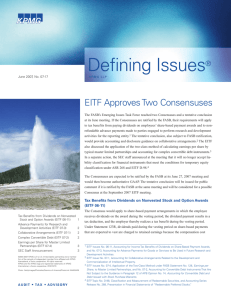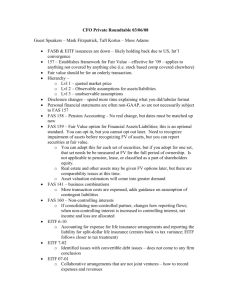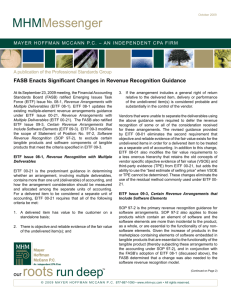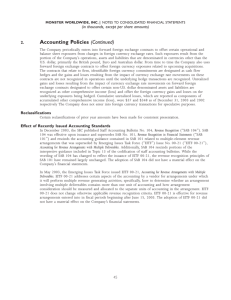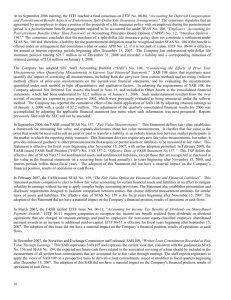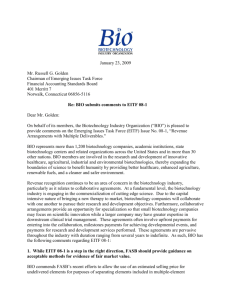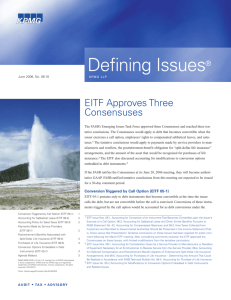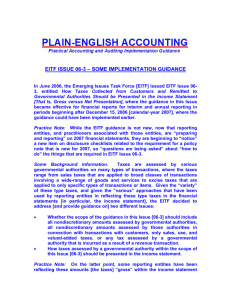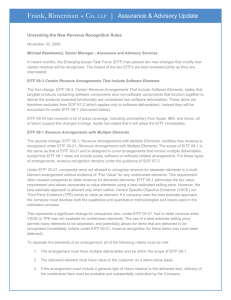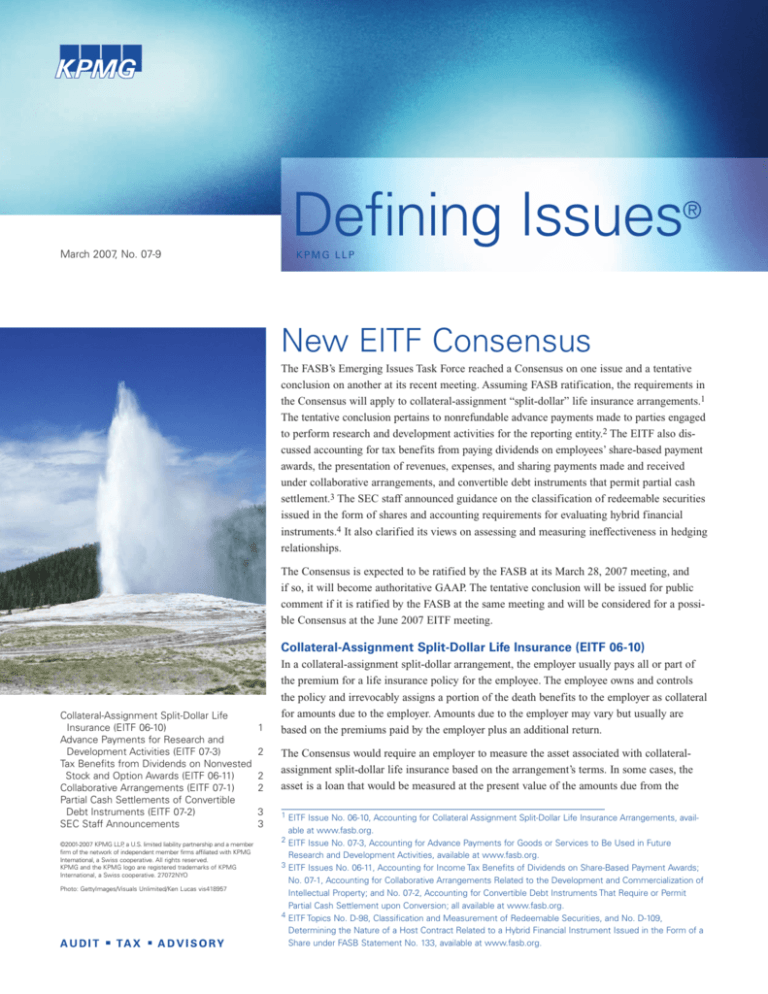
Defining Issues
®
March 2007, No. 07-9
KPMG LLP
New EITF Consensus
The FASB’s Emerging Issues Task Force reached a Consensus on one issue and a tentative
conclusion on another at its recent meeting. Assuming FASB ratification, the requirements in
the Consensus will apply to collateral-assignment “split-dollar” life insurance arrangements.1
The tentative conclusion pertains to nonrefundable advance payments made to parties engaged
to perform research and development activities for the reporting entity.2 The EITF also discussed accounting for tax benefits from paying dividends on employees’ share-based payment
awards, the presentation of revenues, expenses, and sharing payments made and received
under collaborative arrangements, and convertible debt instruments that permit partial cash
settlement.3 The SEC staff announced guidance on the classification of redeemable securities
issued in the form of shares and accounting requirements for evaluating hybrid financial
instruments.4 It also clarified its views on assessing and measuring ineffectiveness in hedging
relationships.
The Consensus is expected to be ratified by the FASB at its March 28, 2007 meeting, and
if so, it will become authoritative GAAP. The tentative conclusion will be issued for public
comment if it is ratified by the FASB at the same meeting and will be considered for a possible Consensus at the June 2007 EITF meeting.
Collateral-Assignment Split-Dollar Life Insurance (EITF 06-10)
Collateral-Assignment Split-Dollar Life
Insurance (EITF 06-10)
Advance Payments for Research and
Development Activities (EITF 07-3)
Tax Benefits from Dividends on Nonvested
Stock and Option Awards (EITF 06-11)
Collaborative Arrangements (EITF 07-1)
Partial Cash Settlements of Convertible
Debt Instruments (EITF 07-2)
SEC Staff Announcements
©2001-2007 KPMG LLP, a U.S. limited liability partnership and a member
firm of the network of independent member firms affiliated with KPMG
International, a Swiss cooperative. All rights reserved.
KPMG and the KPMG logo are registered trademarks of KPMG
International, a Swiss cooperative. 27072NYO
Photo: GettyImages/Visuals Unlimited/Ken Lucas vis418957
1
2
2
2
3
3
In a collateral-assignment split-dollar arrangement, the employer usually pays all or part of
the premium for a life insurance policy for the employee. The employee owns and controls
the policy and irrevocably assigns a portion of the death benefits to the employer as collateral
for amounts due to the employer. Amounts due to the employer may vary but usually are
based on the premiums paid by the employer plus an additional return.
The Consensus would require an employer to measure the asset associated with collateralassignment split-dollar life insurance based on the arrangement’s terms. In some cases, the
asset is a loan that would be measured at the present value of the amounts due from the
1 EITF Issue No. 06-10, Accounting for Collateral Assignment Split-Dollar Life Insurance Arrangements, avail-
able at www.fasb.org.
2 EITF Issue No. 07-3, Accounting for Advance Payments for Goods or Services to Be Used in Future
Research and Development Activities, available at www.fasb.org.
3 EITF Issues No. 06-11, Accounting for Income Tax Benefits of Dividends on Share-Based Payment Awards;
No. 07-1, Accounting for Collaborative Arrangements Related to the Development and Commercialization of
Intellectual Property; and No. 07-2, Accounting for Convertible Debt Instruments That Require or Permit
Partial Cash Settlement upon Conversion; all available at www.fasb.org.
4 EITF Topics No. D-98, Classification and Measurement of Redeemable Securities, and No. D-109,
Determining the Nature of a Host Contract Related to a Hybrid Financial Instrument Issued in the Form of a
Share under FASB Statement No. 133, available at www.fasb.org.
Defining Issues March 2007, No. 07-9 2
employee’s estate upon death. In other cases,
the asset would be measured based on the
cash surrender value of the insurance policy
using the guidance in FASB Technical
Bulletin 85-4 and EITF 06-5.5
Under the Consensus, an employer would
record a liability for a postretirement benefit
if the employer has agreed to maintain the life
insurance policy during the employee’s retirement or provide the employee with a death
benefit. Whether the employer has agreed to
maintain a policy during the employee’s
retirement or provide a death benefit for the
employee would be determined based on the
substantive arrangement with the employee. If
recognized, the liability would be based on
either an agreement to provide a postretirement death benefit or to maintain a life insurance policy, depending on the substance of the
arrangement with the employee.
If ratified, the Consensus would be effective
for fiscal years beginning after December
15, 2007. Early adoption would be permitted
as of the beginning of an employer’s fiscal
year. Employers adopting the Consensus
would choose between retrospective application to all prior periods or application as a
cumulative-effect adjustment to beginning
retained earnings.
Advance Payments for Research
and Development Activities
(EITF 07-3)
This tentative conclusion pertains to nonrefundable advance payments to acquire
goods or pay for services that will be consumed or performed in a future period in
conducting research and development activities for the reporting entity. For example,
biotechnology and software companies may
make up-front nonrefundable payments to
contract research organizations before they
render any service. The tentative conclusion
would require companies to defer incomestatement recognition of advance payments
for research and development activities if the
contracted party has not yet performed activities related to the up-front payment. Amounts
deferred would be recognized by the contracting company as expense when the research
and development activities are performed,
that is, when the goods without alternative
future use are acquired, goods with alternative future use are consumed, or the service
is rendered.6
If a final Consensus is reached on this tentative conclusion, it would be effective for
interim or annual reporting periods in fiscal
years beginning after December 15, 2007.
The application of the Consensus would be
considered a change in accounting principle,
which would be reflected by recognizing a
cumulative-effect adjustment to beginning
retained earnings.
Tax Benefits from Dividends on
Nonvested Stock and Option
Awards (EITF 06-11)
EITF 06-11 would apply to share-based payment arrangements in which the employee
receives dividends on the award during the
vesting period, the dividend payment generates a tax deduction, and the employer thereby
realizes a tax benefit during the vesting period.
The fair value of a share-based payment
arrangement includes the value of a dividend
protection feature because that value is considered in the entity’s share price. Under
Statement 123R, dividends paid during the
vesting period on share-based payments that
are expected to vest are recognized in retained
earnings, rather than the income statement,
because the compensation cost already
reflects the value of those dividends.7
5 FASB Technical Bulletin No. 85-4, Accounting for Purchases of Life Insurance, and EITF Issue No. 06-5,
Accounting for Purchases of Life Insurance—Determining the Amount That Could Be Realized in Accordance
with FASB Technical Bulletin No. 85-4, both available at www.fasb.org.
6 FASB Statement No. 2, Accounting for Research and Development Costs, available at www.fasb.org,
addresses the accounting for research and development costs that have alternative future uses.
7 FASB Statement No. 123 (revised 2004), Share-Based Payment, December 2004, available at www.fasb.org.
8 APB Opinion No. 18, The Equity Method of Accounting for Investments in Common Stock, March 1971.
©2001-2007 KPMG LLP, a U.S. limited liability partnership and a member firm of the KPMG network of independent member firms affiliated with KPMG
International, a Swiss cooperative. All rights reserved. 27072NYO
Therefore, recognizing the dividends as compensation cost would double-count what the
employee receives. In some cases, dividends
paid on share-based awards may be deductible
by the employer for income-tax purposes
even though they are charged to retained
earnings for financial-reporting purposes.
The EITF previously reached a tentative conclusion that would require the tax benefit
received on dividends paid to employees
associated with their share-based payment
awards to be recorded in additional paid-in
capital. At this meeting, the EITF discussed
the relationship between that tentative conclusion and circumstances in which the related
award is forfeited or is no longer expected to
vest. The discussion of the potential accounting implications of those circumstances will
be continued at a future meeting.
Collaborative Arrangements
(EITF 07-1)
Companies in many industries, including the
biotechnology, pharmaceutical, and motion
picture industries, collaborate to jointly develop
and commercialize intellectual property. In
some cases, the collaboration takes place
without creating a separate legal entity. When
there is no separate legal entity, the arrangement is sometimes operated as a virtual joint
venture subject to oversight by a steering
committee that includes representatives of
each party to the collaborative arrangement.
Although the EITF has not yet reached a
tentative conclusion on all of the financialstatement-presentation issues for participants
in such arrangements, the Task Force generally agreed that Opinion 18’s provisions on
the equity method of accounting should not
be applied to a collaborative arrangement
that takes place without creating a separate
legal entity.8 The EITF also discussed the
characteristics that should be considered in defining a collaborative arrangement and how
payments between collaborators should be presented in the income statement. Most EITF
members expressed a preference for net presentation of payments between collaborators and
requested the FASB staff to further develop that approach. Discussions are expected to continue at a future meeting.
Partial Cash Settlements of Convertible Debt Instruments (EITF 07-2)
The EITF considered whether convertible debt instruments that may be settled partially in
cash when converted (described as Instrument C in EITF 90-19) should be accounted for as
convertible debt using the guidance in Opinion 14.9 Instruments within the scope of the issue
do not contain an embedded conversion feature that is required to be separated under
Statement 133.10
The EITF instructed the FASB staff to consider whether other convertible debt instruments
with similar economic characteristics should be included within the scope of this issue. The
EITF is expected to continue its discussions after the FASB staff completes that task.
SEC Staff Announcements
The SEC staff announced a clarification of the position in EITF D-98 on the classification
of redeemable securities issued in the form of shares. The staff believes that the guidance in
EITF 00-19 should be used to evaluate whether the issuer controls the actions or events necessary to issue the maximum number of shares that could be required to be delivered under
share settlement.11 If applying EITF 00-19’s guidance leads the issuer to conclude that it does
not control settlement by delivery of its own shares, cash settlement should be presumed and
the instrument should be classified in temporary equity.
This is a publication of KPMG’s
Department of Professional
Practice—Audit
212-909-5600
Contributing authors:
Mark M. Bielstein
Paul H. Munter
Joseph C. Macina
Robert B. Malhotra
Earlier editions are available at:
www.us.kpmg.com/definingissues
Defining Issues® is a registered trademark of KPMG LLP.
© 2001-2007 KPMG LLP, a U.S. limited liability partnership and a
member firm of the network of independent member firms affiliated
with KPMG International, a Swiss cooperative. All rights reserved.
KPMG and the KPMG logo are registered trademarks of KPMG
International, a Swiss cooperative. 27072NYO
In new EITF D-109, the SEC Staff announced its position on certain approaches to determining whether the characteristics of a host contract to a hybrid financial instrument issued in
the form of a share is more akin to debt or equity. The staff believes that in evaluating an
embedded derivative feature for separation under Statement 133, the consideration of the economic characteristics and risks of the host contract should not ignore the stated or implied
substantive terms and features of the hybrid financial instrument. The SEC staff will consider
comments from the EITF members to clarify the announcement.
The SEC staff commented on assessing and measuring ineffectiveness in a hedging relationship under Statement 133. It clarified that sources of de minimus ineffectiveness would not
necessarily affect the assessment and measurement of ineffectiveness. However, the sources
of ineffectiveness and the registrant’s basis for concluding that the hedge relationship was
highly effective and the ineffectiveness was de minimus should be documented.
Ú
Ú
Ú
The EITF is expected to consider public comments on the tentative conclusion described above
at its June 13-14, 2007 meeting and to decide then whether to make it a Consensus.
The descriptive and summary statements above are not intended to be a substitute for the
texts of the EITF’s Consensus, tentative conclusion, SEC staff announcements, official minutes,
or any other potential or actual requirements. In determining the appropriate accounting
treatment for a transaction, companies should refer to the texts of the applicable documents
that set out requirements, including the formal EITF meeting minutes and Abstracts that will
be made available on the FASB Web site, consider their specific circumstances, and consult
their accounting and legal advisors.
9 EITF Issue No. 90-19, Convertible Bonds with Issuer Option to Settle for Cash upon Conversion, available at
www.fasb.org, and APB Opinion No. 14, Accounting for Convertible Debt and Debt Issued with Stock
Purchase Warrants, March 1969.
10 FASB Statement No. 133, Accounting for Derivative Instruments and Hedging Activities, June 1998, available at www.fasb.org.
11 EITF Issue No. 00-19, Accounting for Derivative Financial Instruments Indexed to, and Potentially Settled in,
a Company’s Own Stock, available at www.fasb.org.

